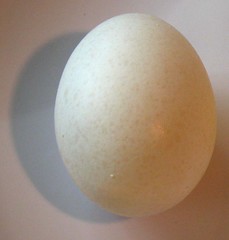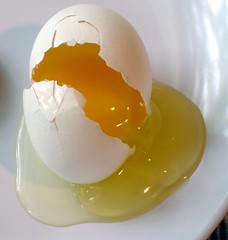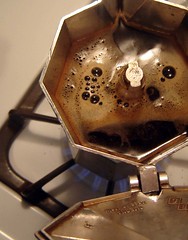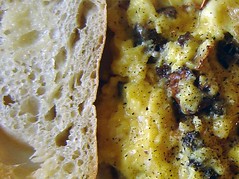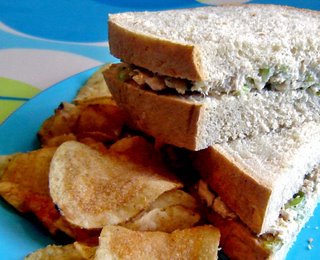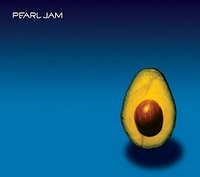This one comes from
Helen, the authority on fish and other sea creatures that you eat. It's called "meme around the world."
Please list 3 recipes you have recently bookmarked from foodblogs to try:
I almost never use the bookmark function in my browser. I try to remember things that looked good and I search for them when I need to. But since the point of this seems to be to flag the good things that other bloggers have cooked, I'll give props to a few dishes that have been in the back of my mind:
-
Sesame miso soup from
In Mol Araan.
-
Pork rilettes from
Toast.
-
Rhapsody in Rhubarb from
The Candied Quince. This last one made me think: Yes, I will buy that pretty fresh rhubarb even if it's not on my list. Now it's sitting on the counter waiting for the right moment. My problem is that this recipe is basically cake filled with rhubarb and I don't want to bake a cake. I might just make the filling.
A foodblog in your vicinity:
A tip from
Yulinka introduced me to
Undelicious, which promises ranting and raving about local food and drink. I'm still getting to know it, so I won't characterize it any more than that.
A foodblog located far from you:
Culiblog, The Netherlands. Every post is intriguing in some way.
A foodblog (or several) you have discovered recently (where did you find it?)
Jay McInerney (that Jay McInerney) is blogging for House & Garden magazine's website. It's about eating fancy and drinking a lot, mostly in Manhattan. I found it through a link from
Epi-log, the blog of the editor of Epicurious, and I read about that a couple of weeks ago on the
Gurgling Cod.
Any people or bloggers you want to tag with this meme?
Not really. I have said before that I like these memes but I think I prefer the system in which people just do them if they look like fun and leave them alone if they don't. If this looks like fun, have yourself some fun.
***
Today was sunny, then rainy, then sunny again, then rainy again, then sunny again briefly before the sun went down. I took this picture

through the mesh of the kitchen window right after taking this one
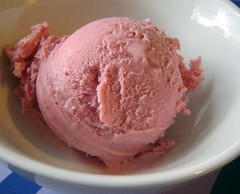
of raspberry frozen yogurt that I made only because I had things in the fridge and freezer that I wanted to get rid of: vanilla yogurt that I bought by accident when I was in a hurry (I always buy unsweetened plain); some extra heavy cream from my last ice cream; and a bag of raspberries that had been in the freezer for just about too long. This fro-yo is cold, sweet, tart, and fruity, but it's not good. Its texture is slushy, not creamy. The recipe is on my flickr (click on the pic).
***
Here's a wacky one from
my sister-in-law.
When did you last die?
Every time we say goodbye, I die a little. Crazy question!
What gets you out of bed in the morning?
The little man.
What became of your childhood dreams?
There was one in which I was naked and being chased by a gorilla, or actually, a man in a gorilla suit. I stopped having it.
What sets you apart from everyone else?
Nothing. I'm just like everyone else.
What is missing from your life?
Charcuterie.
Do you think that everyone can be an artist?
Everyone can be an artist, but not everyone wants to be.
Where do you come from?
I'm thinking this one over. My mother and father.
Do you find your lot an enviable one?
Yes. Most people have it bad.
What have you given up?
Femme Feral said "shrinking." Ambiguous! I have given up diet Pepsi, and I'm a better man for it.
What do you do with your money?
Fold it up in my right pants pocket. The change falls out when I sit on a low couch.
What household task gives you the most trouble?
The bathroom floor.
What are your favorite pleasures?
Food and drink, reading, music, film and television, other people. Not in that order.
What would you like to receive for your birthday?
Ice cream. Coffee table books with arty photography are nice too. We could also use one of those very large televisions that you can hang on a wall.
Cite three living artists whom you detest.
David E. Kelley, Kevin Smith, Rick Moody.
What do you stick up for?
I don't do much sticking up but if I did, I would stick up for equality and justice.
What are you capable of refusing?
Fresh fruit. Most of it makes my mouth and throat feel icky.
What is the most fragile part of your body?
No part of my body is fragile.
What has love made you capable of doing?
Early to bed, early to rise.
What do other people reproach you for?
Not doing what I was supposed to do.
What does art do for you?
Makes life worthwhile.
Write your epitaph
Have some more.
In what form would you like to return?
I would not like to return.
***
New Yorker tables for two on Momofuku, which sounds too obviously like a word you can't say on television:
Momofuku Ramen begins as a bed of noodles; Chang and his fellow-chef, Joaquin Baca (a meat-loving Texan), add pig shoulder and belly and top it with their signature poached egg. The tiny green peas in the bowl--easy to drop with chopsticks--are so robust they bounce. Even Brussels sprouts, which come in a hot kimchi purée, are amped up with thick chunks of bacon.
In a place where the veggies are this loud, the music is bound to be important, and Chang and Baca play everything from Wu-Tang Clan to Ozzy Osbourne, with two firm exceptions: no Springsteen and no Kenny Loggins. No wine, either; just beer and sake. The line cooks, anyway, are the real entertainment. Slamming and sweating their way around an open galley kitchen, they manage to make noodles look dangerous. (The backward hats and skull-and-bones tattoos don'’t hurt.) The other night, one of them threw some squirming crawfish in a pan and lit it on fire, like a pyrotechnic effect at a heavy-metal show. The flames sizzled, and a waitress, squeezing past the stove, reapplied her lip gloss and coyly bumped him with her butt.
Signature poached egg? Bouncing peas? Hot kimchi purée? Loud veggies? Kenny Loggins? Slamming and sweating? Coyly bumped him with her butt? So many things to make me go, Yech.
***
Someone was directed to this blog after searching Yahoo for
pictures of tripe. The #2 hit is my entry
here. #1 is the official site of
Gigli.
 I've been noticing something unusual lately on Flickr. After I post photos with tags (descriptive terms like "mushroom" and "playground") I sometimes search by those tag terms to see what groups my pictures fall into. Each tag can be organized either by recency or by interestingness, which Flickr calculates on the basis of some mysterious formula. I have been noticing that the Milwaukee photos highest in interestingness are almost all of one subject: the Quadracci Pavilion of the Milwaukee Art Museum designed by Santiago Calatrava. I cannot find another city whose interestingness is so dominated by a single edifice. Neither cities famous for a building (Agra, Chartres) nor cities with other prominent Calatravas (Seville, Valencia) have interestingness pages that are virtually all one thing. (A few days ago Milwaukee's page was completely Calatrava; today there are two photos among the top twenty that are of other subjects: one the lake and one of the river.)
I've been noticing something unusual lately on Flickr. After I post photos with tags (descriptive terms like "mushroom" and "playground") I sometimes search by those tag terms to see what groups my pictures fall into. Each tag can be organized either by recency or by interestingness, which Flickr calculates on the basis of some mysterious formula. I have been noticing that the Milwaukee photos highest in interestingness are almost all of one subject: the Quadracci Pavilion of the Milwaukee Art Museum designed by Santiago Calatrava. I cannot find another city whose interestingness is so dominated by a single edifice. Neither cities famous for a building (Agra, Chartres) nor cities with other prominent Calatravas (Seville, Valencia) have interestingness pages that are virtually all one thing. (A few days ago Milwaukee's page was completely Calatrava; today there are two photos among the top twenty that are of other subjects: one the lake and one of the river.)